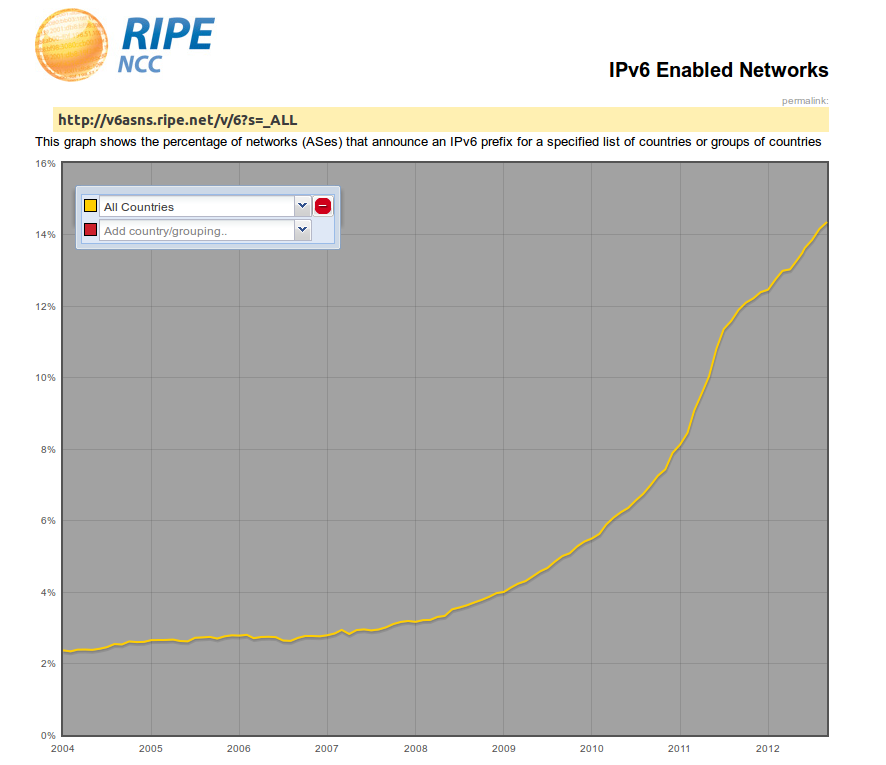2012 IPv6 take-up not matching 2011
Fri, 28 Sep 2012
networking, ipv6
June 6th 2012 was billed as World IPv6 Launch, a subtle rephrasing of last year’s World IPv6 Day to suggest this was something more official. But it’s clear the run up to the event failed to produce the same kind of IPv6 take-up seen in the leadup to the 2011 event.
An encouraging spike in RIPE (Réseaux Internet Protocol Européens) monitored use of IPv6 addressing by Autonomous System operators, usually ISPs or larger web service providers, in 2011 appears to be largely the result of sustained info-marketing campaigns delivered by the likes of the Internet Society and backed by major website organisations such as Google and Facebook preceeding World IPv6 Day in June 2011.
A pleasing interactive graph produced by RIPE shows that on July 1st 2010, global (All Countries) IPv6 take up was recorded at just 6.56%, with only 3301 out of 35083 ISP networks (autonomous systems) having switched on the technology. By the same time a year later, the level was 11.36%, with 4369 out of 38457 ISP networks providing IPv6 functionality, almost a doubling in percentage terms of overall ISP network registrations.

Graph suggests the run up to World IPv6 Day in mid 2011 proved more successful than this year’s World IPv6 Launch
It’s difficult to draw any significant conclusions or explanations as to why this years take-up has not matched 2011, there could me any number of logical narratives. Networks in themselves differ wildly, from small ISPs providing only a few services, to Tier 1 global carriers with owned international fibre. However, the ability to interact with the graph by selecting national, geographical and economic regions of the globe does provide some interesting insights.
One of the main obstacles to transition has been the issue of compatibility. Moving between IPv4 and v6 is like switching between Imperial and Metric measurement, they simply don’t correspond. Furthermore, many routers, including home routers provided en-mass by home and business end-user ISPs simply do not support IPv6. Clearly, a major investment needs to be made at all levels of the industry for IPv6 to gain a serious foothold.
IPv6 brings with it new practices and a learning curve: this in itself has led to slow adoption to the point that, as a globe, we are essentially unready for the depletion of IPv4.
So what can be done if IPv4 and IPv6 aren’t compatible? Well, we can run both together in parallel. So a website currently on IPv4 can also be given an IPv6 address and then reside on both addressing systems. This will ease the complete transition to IPv6 (which almost certainly won’t happen for at least a decade, probably longer). Using both IPv4 and IPv6 in parallel on networks is called dual stacking, and is an increasingly important topic for corporate IT managers and networking technicians. An alternative approach which can be used by homes and offices is IPv6 tunneling, often called 6in4 (IPv6 contained in IPv4) for short. Tunneling is not as reliable or effective as dual stacking, but can be used as an interim measure.
Many ISPs, like ConnetU on their London IP transit, are taking steps to ensure they are IPv6-enabled (if yours isn’t, then hassle them). RIPE offer a star rating to ISPs based on their RIPEness, or readiness for IPv6. The criteria is, loosely:
- Having an IPv6 allocation
- Being visibile in the Routing Information Service (RIS)
- Having reverse DNS (rDNS) set up for IPv6 addresses
What’s most surprising when looking at the companies and organisations in the UK who have been given the maximum 4 star rating, is the conspicuous absence of some major ISPs. Here’s a list of internet providers who don’t yet make the grade:
AOL – BE Unlimited – BT – C2 Internet – CI-Net – Demon Internet – Eclipse Internet – Edge Telecom – EFHBroadband – Elite – Namesco – NewNet – O2 – Onyx Internet – Orange – Plusnet – Post Office – Powernet – Scotnet – Sky Broadband – UTV Internet – Virgin Media / ntl:Telewest – Zen Internet
Come join us on: